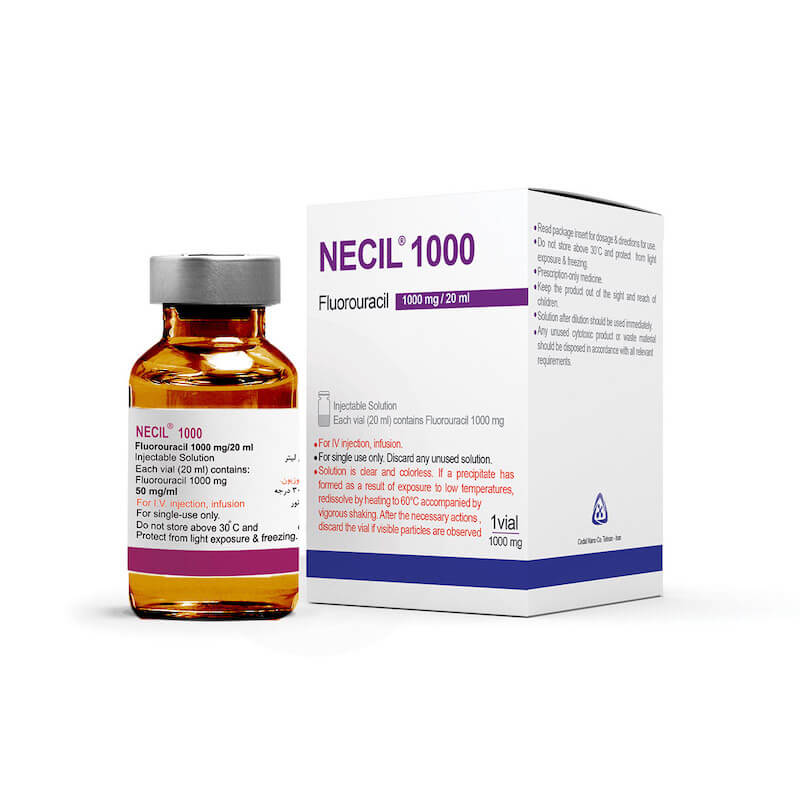Like all medicines, NECIL® can cause side effects, although not everybody gets them.
Very common (occurs in more than 1 out of 10 a user):
– Myelosuppression (Onset: 7-10 days, Nadir: 9-14 days, Recovery: 21-28 days), neutropenia, thrombocytopenia, leucopenia, agranulocytosis, anaemia and pancytopenia, Bronchospasm, immunosuppression with an increased risk of infection, Infections, Hyperuricemia, Ischemic ECG abnormalities- Gastrointestinal adverse events are very common and may be life-threatening. Mucositis (stomatitis, eosophagitis, pharyngitis, proctitis), anorexia, watery diarrhoea, nausea, vomiting. Alopecia may be seen in a substantial number of cases, particularly females, but is reversible. Palmar-plantar erythrodysaesthesia syndrome (hand-foot syndrome) has been noted with protracted and high dose continuous infusion. The syndrome begins with dysaesthesia of the palms and soles that progress to pain and tenderness. There is associated symmetrical swelling and erythema of the hand and foot- Delayed wound healing, epistaxis, malaise, weakness, fatigue-
Common (occurs in more than 1 out of 10 out of 100 users):
-Febrile neutropenia- Angina pectoris-like chest pain.
Uncommon (occurs in more than 1 out of 10 out of 1000users):
– Euphoria- Nystagmus, headache, dizziness, symptoms of Parkinson’s disease, pyramidal signs, euphoria, somnolence- various types of ocular toxicity- Arrhythmia, myocardial infarction, myocardial ishchemia myocarditis, heart insufficiency, dilative cardiomyopathy, cardiac shock- Hypotension- Dehydration, sepsis, gastrointestinal ulceration and bleeding (may result in therapy being discontinued), sloughing- liver cell damage- Dermatitis, skin alterations (e.g. dry skin, fissure erosion, erythema, pruritic maculopapular rash), exanthema, urticaria, photosensitivity, hyperpigmentation of the skin, streaky hyperpigmentation or depigmentation near the veins. Changes in the nails (e.g. diffuse superficial blue pigmentation, hyperpigmentation, nail dystrophy, pain and thickening of the nail bed, paronychia) and onycholyse- Spermatogenesis and ovulation disorder-
Rare (occurs in more than 1 out of 10 out of 10,000 users):
Generalized allergic reactions, anaphylaxis, anaphylactic shock- Increase of T4 (total thyroxin), increase of T3 (total riiodothyronine)- Reversible confusional state may occur- Cerebral, intestinal and peripheral ischemia, Raynaud’s syndrome, thromboembolism, thrombophlebitis/vein tracking-
Very rare (occurs in less than 1 out of 10,000 users):
Disorientation- Symptoms of leucoencephalopathy including ataxia- Acute cerebellar syndrome, dysarthria, confusion, disorientation, myasthenia, aphasia, convulsion or coma, kidney failure- Cardiac arrest, sudden cardiac death- Liver necrosis (cases with fatal outcome), Biliary sclerosis, Cholecystitis-
Not known (cannot be estimated from the available data)
- Peripheral neuropathy may occur, hyperammonaemic encephalopathy- Tachycardia, breathlessness, pericarditis- Fever, vein discolouration proximal to injection sites.
Reporting suspected adverse reactions after authorisation of the medicinal product is important. It allows continued monitoring of the benefit/risk balance of the medicinal product. Healthcare professionals are asked to report any suspected adverse reactions via the Yellow Card Scheme (www.adr.ttac.ir).


